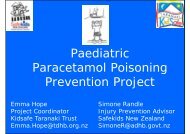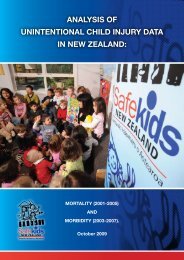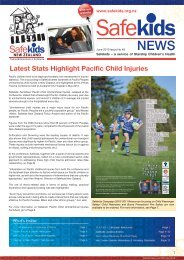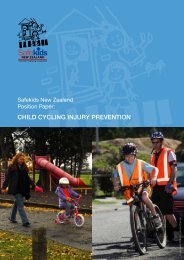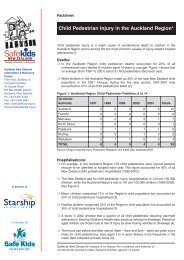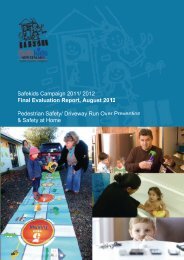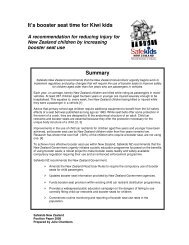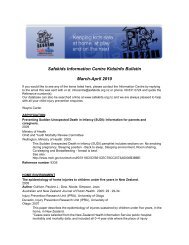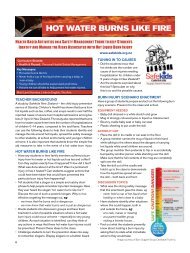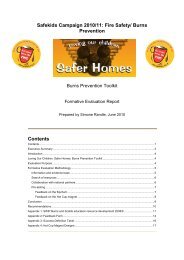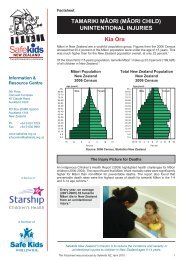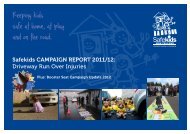MUST SEE CHILD INJURY PREVENTION SESSIONS! - Safekids
MUST SEE CHILD INJURY PREVENTION SESSIONS! - Safekids
MUST SEE CHILD INJURY PREVENTION SESSIONS! - Safekids
You also want an ePaper? Increase the reach of your titles
YUMPU automatically turns print PDFs into web optimized ePapers that Google loves.
TRAUMA TEAM UPDATE: Starship Children’s Health<br />
Major sponsor:<br />
Child cycling injury admissions to Starship<br />
Children’s Hospital January 2007 to December 2011<br />
Data supplied by Rangi Dansey, Starship Trauma Systems Coordinator. Analysis by Dr Patricia Bolton, <strong>Safekids</strong> NZ Policy Analyst<br />
During the 5 year period from January 2007 to December 2011,<br />
301 children between the ages of 0-14 years were admitted to<br />
Starship Children’s Hospital with unintentional cycling related<br />
injuries. This number of admissions equates to an average of 5<br />
admissions per month.<br />
Demographics<br />
Demographics of cycling injuries aligned with national data 1 , with<br />
the highest number of admissions being for Māori and European<br />
males aged 10-14 years. Fifty-eight percent (173) of cycling related<br />
admissions were children aged 10-14 years, thirty-eight percent<br />
(115) aged 5-9 years, and four percent (13) aged 0-4 years. The<br />
average age at admission was 10 years.<br />
The majority of children admitted were male (77%, 233). Nineteen<br />
percent (56) of children admitted were coded as Māori, eleven<br />
percent (34) Pacific, fifty-seven percent (171) European, six percent<br />
(18) Asian and seven percent (22) Other.<br />
Cycling injury admissions Jan 2007- Dec 2011 by ethnicity and age<br />
0-4 years 5-9 years 10-14 years Total<br />
Māori 4 15 37 56<br />
Pacific 4 16 14 34<br />
European 4 64 103 171<br />
Asian 0 9 9 18<br />
Other 1 11 10 22<br />
Total 13 115 173 301<br />
Seasonal trend<br />
Child cycling related admissions varied by month of the year, with<br />
the highest number of admissions during the warmer months of<br />
January-March.<br />
Place and mechanism<br />
The major places where injuries occurred were the street (117, 39%),<br />
followed by recreational areas (71, 24%) and the home (60, 20%).<br />
Fourteen percent (43) of accidents were coded as traffic accidents<br />
involving a motor-vehicle; the remaining eighty-six percent (258) of<br />
accidents were not traffic related.<br />
The main causes of injury were described as falling off, losing<br />
control, striking against/accidentally struck and motor vehicle<br />
collison (including collison with cars exiting driveways) 2 .<br />
Farm, 1, 0%<br />
Mine, 1, 0%<br />
Public Building, 3, 1%<br />
Unknown, 18, 6%<br />
Other, 31, 10%<br />
Home, 60, 20%<br />
PLACE OF <strong>INJURY</strong><br />
Injury location and type<br />
When categorised by body region:<br />
Street, 117, 39%<br />
Recreation, 71, 24%<br />
• The upper extremity was the most common site of injury (38%,<br />
183), and upper extremity fractures were the leading cause of<br />
injury (36%, 171).<br />
• Fractures to the lower extremity (11%, 52), and abrasions,<br />
lacerations and contusions to the head and neck (10%, 48),<br />
lower extremity (9%, 43) and trunk (9%, 43) were the next most<br />
common injuries sustained.<br />
• Internal organ injury (8%, 36), and head and neck fracture (7%,<br />
32) were also prominent injuries.<br />
Cycling injury by body region 3<br />
Head and neck total<br />
• Concussion<br />
• Cerebral haemorrhage<br />
• Fracture<br />
• Abrasion/laceration/contusion<br />
Upper extremity total<br />
• Fracture<br />
• Abrasion/laceration/contusion<br />
• Other<br />
Lower extremity total<br />
• Fracture<br />
• Abrasion/laceration/contusion<br />
• Other<br />
Trunk total<br />
• Internal organ injury<br />
• Fracture<br />
• Abrasion/laceration/contusion<br />
Cycling injury<br />
(n=480) percentage<br />
120<br />
18<br />
22<br />
32<br />
48<br />
183<br />
171<br />
11<br />
1<br />
96<br />
52<br />
43<br />
1<br />
81<br />
36<br />
2<br />
43<br />
25%<br />
4%<br />
5%<br />
7%<br />
10%<br />
38%<br />
36%<br />
2%<br />
0%<br />
20%<br />
11%<br />
9%<br />
0%<br />
17%<br />
8%<br />
0%<br />
9%<br />
Injury severity<br />
Using the Injury Severity Score (ISS) (an internationally recognised<br />
method for calculating the combined severity of injuries sustained)<br />
ten percent (30) of injuries were moderate or severe (ISS ≥ 10).<br />
Length of hospital admission<br />
The median length of hospital admission for all children was 2 days.<br />
Median length of admission for moderate or severe injury (ISS ≥ 10)<br />
was 5.5 days; median length of admission for all other cases (ISS <<br />
10) was 1 day.<br />
Helmet use<br />
Helmet use was unknown for 56 percent (170) of admissions. Of<br />
the remaining admissions (44%, 131), fifty-three percent (69) were<br />
wearing a helmet when injured, and forty-seven percent (62) were not<br />
wearing a helmet when injured. For the 131 admissions where use of<br />
helmets was documented, there was no difference in helmet use by<br />
gender or age. Differences in helmet use by ethnicity may be present,<br />
however the high number of unknown helmet use limits interpretation.<br />
Key Safety Messages for Child Cyclists:<br />
• Be smart – plan safe cycle routes with an adult, the best riders<br />
are skilled riders.<br />
• Be safe – no helmet no bike.<br />
• Be seen – wear bright colours and use reflective gear.<br />
Key Safety Messages for Drivers<br />
• Slow Down and Look Out For Kids.<br />
1 <strong>Safekids</strong> New Zealand. <strong>Safekids</strong> New Zealand Position Paper: Child Cycling Injury<br />
Prevention. Auckland, <strong>Safekids</strong> New Zealand: 2012.<br />
2 Due to data description limitations figures for causes are not provided, so as to avoid<br />
inaccuracy and misrepresentation.<br />
3 A total of 486 injuries were coded for the 301 admissions. Six of these injuries (3<br />
abrasions and 3 contusions) are not included in the table as the body region affected was<br />
not specified.<br />
7<br />
<strong>Safekids</strong> News: September 2012 Issue No 58



